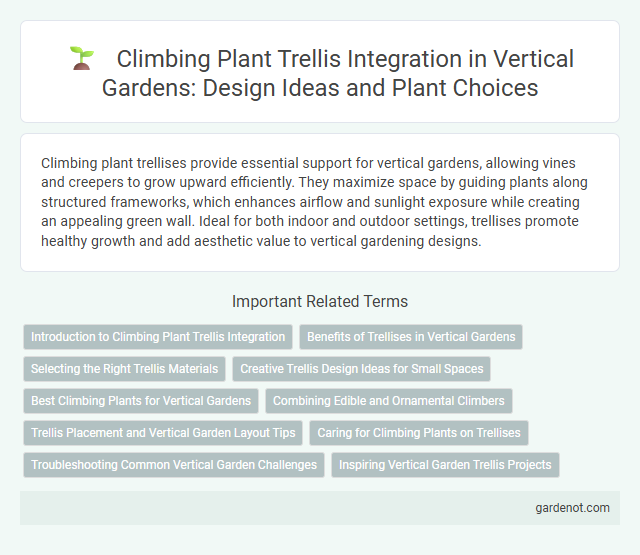Climbing plant trellises provide essential support for vertical gardens, allowing vines and creepers to grow upward efficiently. They maximize space by guiding plants along structured frameworks, which enhances airflow and sunlight exposure while creating an appealing green wall. Ideal for both indoor and outdoor settings, trellises promote healthy growth and add aesthetic value to vertical gardening designs.
Introduction to Climbing Plant Trellis Integration
Climbing plant trellises provide essential support structures for vertical gardens, promoting healthy growth and maximizing space efficiency. These frameworks made from materials like wood, metal, or bamboo guide plants such as ivy, clematis, and climbing roses towards upward expansion. Integrating trellises in vertical garden systems enhances air circulation, increases sunlight exposure, and adds aesthetic value to urban green spaces.
Benefits of Trellises in Vertical Gardens
Trellises in vertical gardens provide essential support for climbing plants, promoting healthier growth by allowing better air circulation and increased sunlight exposure. They maximize limited space, making vertical gardening ideal for urban environments with restricted ground area. This structure also enhances garden aesthetics by creating visually appealing plant arrangements and improving overall plant health.
Selecting the Right Trellis Materials
Choosing the right materials for a climbing plant trellis is essential for durability and plant support, with options including wood, metal, and PVC. Wood offers a natural aesthetic and is suitable for most climbing plants but requires treatment for outdoor longevity. Metal trellises provide strong support and weather resistance, while PVC is lightweight and resistant to rot, ideal for humid environments.
Creative Trellis Design Ideas for Small Spaces
Climbing plant trellises maximize vertical growth in small spaces by utilizing creative design concepts such as modular panels, angled frames, and multi-tiered structures that provide ample support while maintaining aesthetic appeal. Incorporating materials like lightweight metal, bamboo, or reclaimed wood enhances durability and blends seamlessly with urban environments. Innovative designs integrate planter boxes and hanging pots to increase greenery without occupying floor area, making them perfect for balconies, patios, and compact gardens.
Best Climbing Plants for Vertical Gardens
Best climbing plants for vertical gardens include English ivy, clematis, and star jasmine, known for their vigorous growth and ability to cover trellises quickly. Wisteria and climbing roses offer vibrant flowers and fragrant blooms, enhancing the aesthetic appeal of vertical spaces. Hardy varieties like honeysuckle and trumpet vine provide year-round greenery and attract pollinators, making them ideal for sustainable vertical gardening.
Combining Edible and Ornamental Climbers
Combining edible and ornamental climbers on a climbing plant trellis creates a visually appealing and functional vertical garden that maximizes space and enhances biodiversity. Popular edible climbers such as peas, beans, and cucumbers complement ornamental varieties like clematis, honeysuckle, and jasmine, offering a dynamic blend of color, fragrance, and harvest. Strategic placement of these climbers improves sunlight exposure and air circulation, ensuring healthy growth while providing fresh produce alongside decorative blooms.
Trellis Placement and Vertical Garden Layout Tips
Position the climbing plant trellis in areas with ample sunlight and sufficient airflow to promote healthy growth and prevent mold or mildew. Ensure the trellis is securely anchored to support the weight of mature plants and integrate it seamlessly into the vertical garden layout by spacing it evenly with other vertical elements for balanced aesthetics. Optimize vertical garden design by varying plant heights, using tiered trellises, and allowing easy access for maintenance and watering.
Caring for Climbing Plants on Trellises
Caring for climbing plants on trellises requires regular pruning to promote healthy growth and prevent overcrowding. Ensure the plants receive adequate sunlight and water consistently, using well-draining soil to avoid root rot. Inspect trellises periodically for stability and adjust ties to support the vines without constricting stems.
Troubleshooting Common Vertical Garden Challenges
Climbing plant trellises in vertical gardens often face issues such as inadequate support leading to plant collapse or uneven growth due to improper securing. Regularly inspecting trellis stability and adjusting plant ties can prevent structural failures and promote healthy vine development. Using durable materials resistant to weather and ensuring proper spacing optimize plant attachment and reduce maintenance problems.
Inspiring Vertical Garden Trellis Projects
Climbing plant trellises transform vertical gardens by providing structured support that enhances plant growth and aesthetic appeal. Inspiring vertical garden trellis projects showcase a variety of materials such as wood, metal, and bamboo, each tailored to support climbing plants like clematis, ivy, and jasmine. These innovative designs not only maximize space in small urban gardens but also create living walls that improve air quality and add vibrant greenery to urban environments.
Climbing plant trellis Infographic

 gardenot.com
gardenot.com